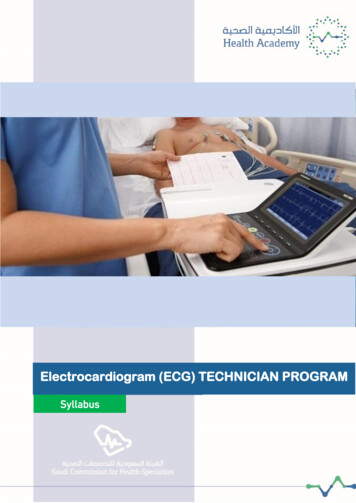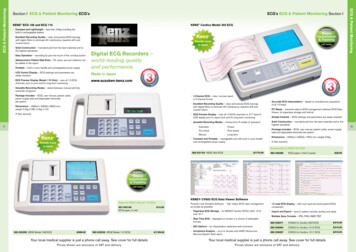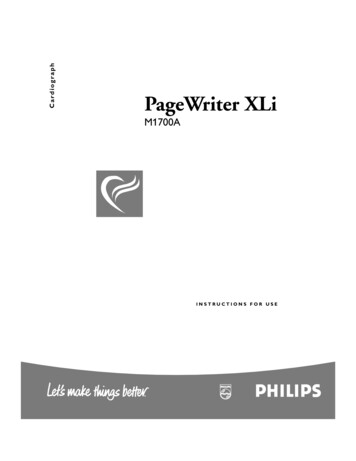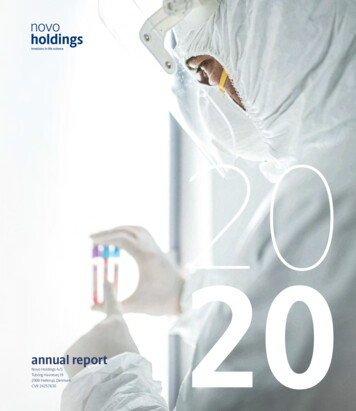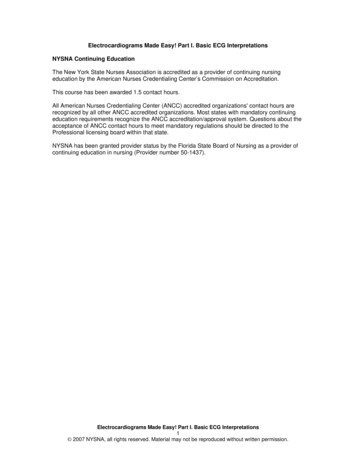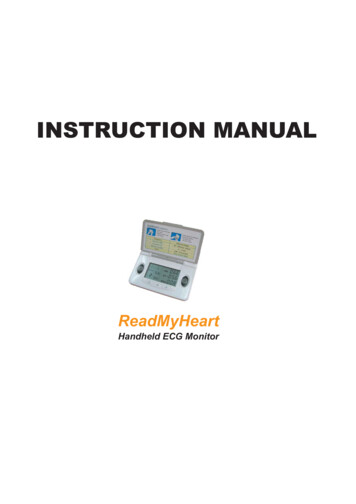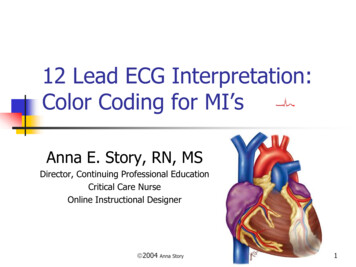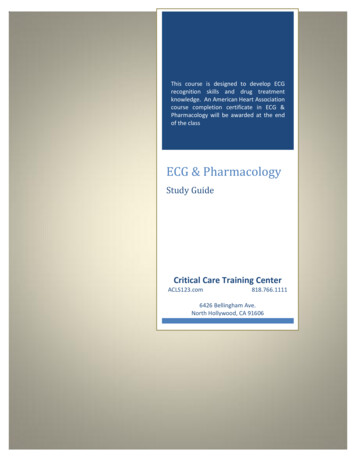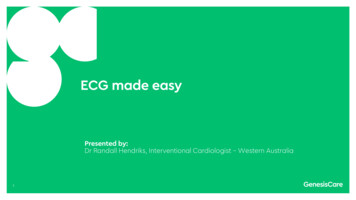
Transcription
DE NOVO CLASSIFICATION REQUEST FORECG APPREGULATORY INFORMATIONFDA identifies this generic type of device as:Electrocardiograph software for over-the-counter use. An electrocardiographsoftware device for over-the-counter use creates, analyzes, and displayselectrocardiograph data, and can provide information for identifying cardiac arrhythmias.This device is not intended to provide a diagnosis.NEW REGULATION NUMBER: 21 CFR 870.2345CLASSIFICATION: Class IIPRODUCT CODE: QDABACKGROUNDDEVICE NAME: ECG AppSUBMISSION NUMBER: DEN180044DATE OF DE NOVO: August 14, 2018CONTACT:Apple Inc.One Apple Park WayCupertino, CA 95014INDICATIONS FOR USEThe ECG app is a software-only mobile medical application intended for use with theApple Watch to create, record, store, transfer, and display a single channelelectrocardiogram (ECG) similar to a Lead I ECG. The ECG app determines the presenceof atrial fibrillation (AFib) or sinus rhythm on a classifiable waveform. The ECG app isnot recommended for users with other known arrhythmias.The ECG app is intended for over-the-counter (OTC) use. The ECG data displayed by theECG app is intended for informational use only. The user is not intended to interpret ortake clinical action based on the device output without consultation of a qualifiedhealthcare professional. The ECG waveform is meant to supplement rhythmclassification for the purposes of discriminating AFib from normal sinus rhythm and notintended to replace traditional methods of diagnosis or treatment.The ECG app is not intended for use by people under 22 years old.
LIMITATIONSThe device has only been evaluated for the detection of AFib or normal sinus rhythm andis not intended to detect any other type of arrhythmia. It cannot detect heart attacks. Ifyou ever experience chest pain, pressure, tightness, or what you think is a heart attack,call emergency services.Apple Watch may be unable to collect data when Apple Watch is in close vicinity tostrong electromagnetic fields (e.g. electromagnetic anti-theft systems, metal detectors).DO NOT wear your Apple Watch during a medical procedure (e.g., magnetic resonanceimaging, diathermy, lithotripsy, cautery and external defibrillation procedures).DO NOT change your medication without talking to your doctor.Not intended for use by individuals under age 22.Not intended for use by individuals previously diagnosed with AFib.Notifications made by this feature are potential findings, not a complete diagnosis ofcardiac conditions. All notifications should be reviewed by a medical professional forclinical decision-making.Apple does not guarantee that you are not experiencing an arrhythmia or other healthconditions even in the absence of an irregular rhythm notification. You should notifyyour physician if you experience any changes to your health.The clinical study did not quantitatively assess the quality of the ECG waveformproduced by the ECG App. The ECG produced by the ECG App is not intended forclinical use or as the basis for diagnosis or treatment. The ECG waveform is onlyintended for informational use.PLEASE REFER TO THE LABELING FOR A COMPLETE LIST OF WARNINGS,PRECAUTIONS AND CONTRAINDICATIONS.DEVICE DESCRIPTIONThe device (ECG App) comprises a pair of mobile medical apps — one on Apple Watch (theWatch App) and the other on the iPhone (iPhone App) — intended to record, store, transfer, anddisplay a single lead ECG signal similar to a lead I. The ECG Watch App is intended to analyzethis single lead data and detect the presence of atrial fibrillation (referred into this document asAFib or AF) and sinus rhythm in adults. It is also intended to acquire and analyze the single leadECG recordings for display on the iPhone. The ECG iPhone App is included in the Health App,which is intended to store, manage, and share health and fitness data, and comes pre-installed onevery iPhone.De Novo Summary (DEN180044)Page 2 of 15
Figure 1: Apple Watch App and iPhone App components of the ECG App deviceThe ECG Watch App instructs the user to take an ECG measurement by holding their finger onthe digital crown of the watch. The watch also contains electrodes on the back of the devicewhich are in continuous contact with the user’s wrist. The watch acquires the electrical potentialbetween the electrodes and digital crown. The Watch App will display a visual representation ofthe ECG waveform to provide information regarding signal quality during the session. Thewaveform displayed on the watch during the session is not intended for clinical purposes. Thesession will last for 30 seconds. Upon completion of the recording, the ECG Watch Appanalyzes the acquired ECG data and produces a waveform that is similar to a Lead I ECG for thepurposes of AF and sinus rhythm evaluation, calculates average heart rate, and classifies therhythm of the waveform (collectively called “session result”).De Novo Summary (DEN180044)Page 3 of 15
Figure 2: Taking a Measurement with the Digital Crown and the Watch AppThe ECG rhythm will be classified into one of the following categories:1. Sinus rhythm2. Atrial Fibrillation3. InconclusiveThere are two categories of Inconclusive rhythms: one for high heart rate, low heart rate or otherarrhythmias; and one that is the result of poor signal quality and therefore unreadable by thealgorithm.De Novo Summary (DEN180044)Page 4 of 15
Figure 3: ECG App analysis outputsOnce the ECG Watch App analyzes the ECG data, the Watch App displays the rhythmclassification, average heart rate, and a description of the rhythm classification to the user ontheir Apple Watch. The session result is saved in Watch HealthKit and is then retrieved andstored in HealthKit on the paired iPhone.Once the user sees the result of a given session on the Apple Watch App, the user will have theopportunity to pick from the following list of symptoms, which will be saved as part of thesession result in Watch HealthKit: Rapid, pounding, or fluttering heartbeat Skipped heartbeat Fatigue Shortness of breath Chest tightness or pain Fainting Dizziness Other NoneDe Novo Summary (DEN180044)Page 5 of 15
SUMMARY OF NONCLINICAL/BENCH STUDIESEVALUATION OF INPUT SIGNAL QUALITYTo support the ability of the ECG App to obtain an ECG of sufficient quality for displayand analysis, electromagnetic compatibility, electrical safety, and signal acquisitioninformation was provided, in addition to clinical testing. Specifically, the Apple Watchclaims conformance to EU and FCC compliance statements. The FCC listing includes allinformation needed for 47 CFR compliance. The Apple Watch conforms to EU standardsEN 301 489-1 (V2.2.20), EN 301 489-3 (V2.1.1), EN 301 489-17 (V3.2.0), and EN 301489-52 (V1.1.0). These standards were used as a comparator for IEC 60601-1-2, which isan FDA recognized consensus standard for medical device EMC. The followingcomparison data was submitted for the normative EMC standards referenced by EN 301489-1 V2.2.20 and IEC 60601-1-2 (4th Edition): Radiated/Conducted Emissions Voltage Fluctuations and Flicker Harmonic Emissions Electrostatic Discharge Radiated Immunity and proximity fields Conducted Immunity Electrical Fast Transient/Burst Surge Immunity Voltage Dips/Interruptions Power Frequency Magnetic Fields Common EmittersElectrical safety was assessed according to IEC 62368-1 (2014), “Audio/video,information and communication technology equipment – Part 1: Safety requirements.”Signal acquisition and platform (hardware) performance was assessed according to IEC60601-2-47, “Particular requirements for the basic safety and essential performance ofambulatory electrocardiographic systems.” Platform performance testing included: Input differential range Input common-mode range ADC sampling rate ADC effective resolution Bandwidth Common-mode rejection Gain accuracy Linearity and dynamic range Input impedance System noise Frequency response Amplitude response Gain setting and stability Ambient temperature, humidity, and atmospheric pressureDe Novo Summary (DEN180044)Page 6 of 15
“Unclassified.” Unclassified rhythms include any rhythms with rates 120 or 50 beats/min(bpm), regular rhythms with rates 100 bpm or more than 4 ectopic beats.Three blinded independent board-certified cardiologists reviewed all ECG recordings andassigned a classification of SR, AF, unreadable, or others. Others classification was defined toinclude normal sinus with premature ventricular contraction (if 4 beats in the strip), normalsinus with PACS, 2nd degree block, AF with a rate 120 bpm, and supraventricular tachycardia.If the readers disagreed on the diagnosis, the final interpretation was determined by the simplemajority rule.In a subset of randomized selected subjects (Waveform Assessment Analysis Set), 3 independentcertified cardiographic technicians synced and overlaid each ECG App rhythm strip with theLead I strip of the corresponding 12-lead ECG. The first 6 consecutive distinct readable PQRSTcomplexes were identified and used to determine if the morphology of the complexes appearedto overlay to the unaided eye. For the first two QRS complexes, the evaluators also measuredand compared the R wave amplitude between the ECG App strip and the reference strip.Study EndpointsPrimary EndpointSensitivity and specificity of the ECG App algorithm in detecting AF compared withphysician-adjudicated 12-lead ECG. The sensitivity and specificity performance goalswere set at 90% and 92% respectively. Per the protocol, only readable and classifiable(Classifiable Analysis Set) paired recordings are included in the diagnosticperformance assessment.Secondary EndpointThe ECG app produces a waveform that provides clinically equivalent information tothe gold standard (Lead I ECG). The following criteria assess the endpoint1. Qualitative assessmentThe proportion of paired ECG strips appear to overlay to the unaided eye 0.802. Quantitative assessmentThe proportion of paired R-wave amplitude measurements within 2 mm of eachother 0.80ResultsSubject characteristicsThe study enrolled a total of 602 subjects at 5 investigational sites. Subject disposition isprovided in Figure below. The study analysis excluded 14 subjects in the SR cohort due to ahistory of paroxysmal AF.De Novo Summary (DEN180044)Page 9 of 15
The ECG output of the device is limited to information use only. The qualitative nature of theWaveform Assessment could not determine if the ECG was sufficient for diagnostic use.Please see the Limitations section above for important contraindications, warnings andprecautions presented in the device labeling.RISKS TO HEALTHThe table below identifies the risks to health that may be associated with use ofelectrocardiograph software for over-the-counter use:Table 6: Identified Risks to Health and Mitigation MeasuresIdentified Risks to HealthMitigation MeasuresPoor quality ECG signal resulting in Clinical performance testingfailure to detect arrhythmiaHuman factors testingLabelingMisinterpretation and/or overHuman factors testingreliance on device output, leading to: Labeling Failure to seek treatmentdespite acute symptoms Discontinuing or modifyingtreatment for chronic heartconditionFalse negative resulting in failure to Clinical performance testingidentify arrhythmia and delay ofSoftware verification, validation, and hazard analysisfurther evaluation or treatmentNon-clinical performance testingFalse positive resulting in additional Clinical performance testingunnecessary medical proceduresSoftware verification, validation, and hazard analysisNon-clinical performance testingLabelingSPECIAL CONTROLSIn combination with the general controls of the FD&C Act, the electrocardiograph software forover-the-counter use is subject to the following special controls:1. Clinical performance testing under anticipated conditions of use must demonstrate thefollowing:a. The ability to obtain an ECG of sufficient quality for display and analysis; andb. The performance characteristics of the detection algorithm as reported bysensitivity and either specificity or positive predictive value.2. Software verification, validation, and hazard analysis must be performed. Documentationmust include a characterization of the technical specifications of the software, includingthe detection algorithm and its inputs and outputs.De Novo Summary (DEN180044)Page 13 of 15
3. Non-clinical performance testing must validate detection algorithm performance using apreviously adjudicated data set.4. Human factors and usability testing must demonstrate the following:a. The user can correctly use the device based solely on reading the device labeling;andb. The user can correctly interpret the device output and understand when to seekmedical care.5. Labeling must include:a. Hardware platform and operating system requirements;b. Situations in which the device may not operate at an expected performance level;c. A summary of the clinical performance testing conducted with the device;d. A description of what the device measures and outputs to the user; ande. Guidance on interpretation of any results.BENEFIT-RISK DETERMINATIONThe ECG App is intended to record a single-channel ECG and detect the presence of atrialfibrillation and regular rhythm. As an ambulatory single-lead ECG recorder, there are minimalsafety concerns. The probable risks associated with using the ECG App are nearly all related tofalse results in AF detection or human use errors. False negative results may falsely reassure theuser and cause delay or inappropriate changes in medical evaluation and treatment. A falsepositive result can lead to additional unnecessary medical procedures. In the clinical study, thefalse-positive and false-negative rates were 0.4% and 1.7% respectively when the deviceprovided a rhythm classification. However, approximately 1 in 8 readings were inconclusive.There is also a risk of misinterpretation of the output by the user which can be compounded byfalse positive/negative results. However, this risk can be mitigated through labeling and requiringa human factors evaluation of whether users understand how the device output should beinterpreted and when to seek further care from a physician.The device provides the user a convenient and readily accessible means to record a 30-secondsingle lead electrocardiogram (ECG) during the time of symptoms or unusual findings (e.g.,irregular pulses). The ECG can then be reviewed by a medical professional to determine if thesymptoms may be related to cardiac rhythm abnormalities. This is especially valuable for userswith recurrent, transient but infrequent symptoms, which can be difficult to catch with traditionalcardiac monitors. The information can be helpful to make the medical evaluation more efficientand obviate some unnecessary procedures.In the clinical study, the device was accurate in discriminating AF from sinus rhythm. For userswith undiagnosed AF, the device has the potential to provide early detection of the disease.Timely diagnosis of atrial fibrillation and consequent use of chronic oral anticoagulation in highrisk patients can reduce the risk of stroke. Even in otherwise healthy users, atrial fibrillation maybe the first manifestation of other diseases. In most cases, early detection and prompt treatmentare likely to improve clinical outcomes.De Novo Summary (DEN180044)Page 14 of 15
Overall, the probable benefits outweigh the probable risks given the available informationconcerning the benefits and risks. There is reasonable assurance of the safety and effectivenessfor this device for the intended use.Patient PerspectivesThis submission did not include specific information on patient perspectives for this device.Benefit/Risk ConclusionIn conclusion, given the available information above, for the following indication statement:The ECG app is a software-only mobile medical application intended for use with theApple Watch to create, record, store, transfer, and display a single channelelectrocardiogram (ECG) similar to a Lead I ECG. The ECG app determines the presenceof atrial fibrillation (AFib) or sinus rhythm on a classifiable waveform. The ECG app isnot recommended for users with other known arrhythmias.The ECG app is intended for over-the-counter (OTC) use. The ECG data displayed by theECG app is intended for informational use only. The user is not intended to interpret ortake clinical action based on the device output without consultation of a qualifiedhealthcare professional. The ECG waveform is meant to supplement rhythmclassification for the purposes of discriminating AFib from normal sinus rhythm and notintended to replace traditional methods of diagnosis or treatment.The ECG app is not intended for use by people under 22 years old.The probable benefits outweigh the probable risks for the ECG App. The device providesbenefits and the risks can be mitigated by the use of general controls and the identified specialcontrols.CONCLUSIONThe De Novo request for the ECG App is granted, and the device is classified under thefollowing:Product Code: QDADevice Type: Electrocardiograph software for over-the-counter useClass: IIRegulation Number: 21 CFR 870.2345De Novo Summary (DEN180044)Page 15 of 15
information needed for 47 CFR compliance. The Apple Watch conforms to EU standards EN 301 489-1 (V2.2.20), EN 301 489-3 (V2.1.1), EN 301 489-17 (V3.2.0), and EN 301 . which is an FDA recognized consensus standard for medical device EMC. The following . Software verification, validation, and hazard analysis . Non-clinical performance testing
